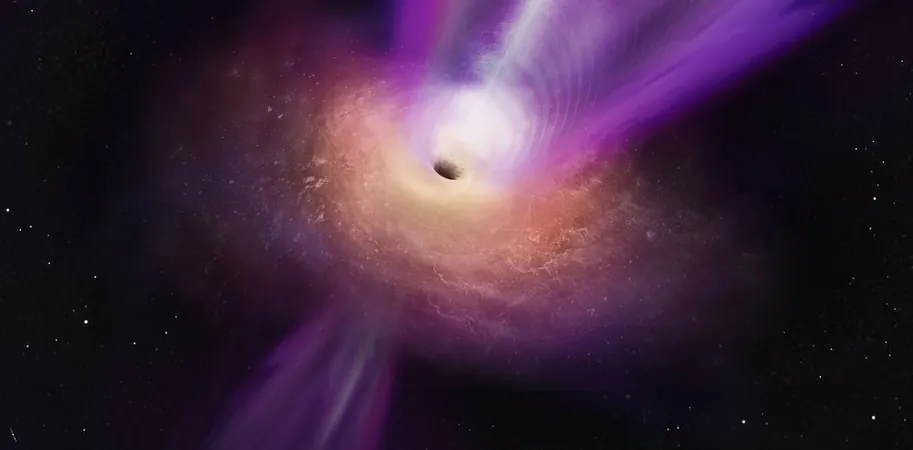
Unveiling the Cosmic Beacons: How Jets from Black Holes Illuminate Life's Potential in the Universe!
2025-03-31
Author: Michael
In the vast expanse of the universe, one of the most astonishing phenomena is a radio quasar—a spinning black hole that emits streams of highly energetic particles at incredible speeds.
While the thought of approaching such an entity might mean instant destruction due to its powerful gravitational pull and extreme heat, researchers have discovered that studying these cosmic giants and their jets can actually guide them in the search for potentially habitable worlds beyond our own.
Understanding Black Holes and Their Cosmic Role
Black holes are incredibly massive objects in space whose gravity is so strong that nothing, not even light, can escape their grasp. At the center of every massive galaxy lies a supermassive black hole, often surrounded by a dense structure known as an accretion disk—a swirling mixture of hot, electrically charged gas drawn towards the black hole.
These disks emerge when galaxies collide, funneling gas into the core. The density and rotation of this matter play a crucial role in determining the energy output of the black hole. Mergers can create exceptionally energetic black holes, but in spiral galaxies, gas tends to be less abundant, resulting in black holes that produce less energy.
A fascinating aspect of black holes is their ability to generate jets of high-energy particles. As they rotate, magnetic fields from the surrounding plasma become entwined, releasing their stored energy and sending jets streaming out into space. These jets can profoundly impact the star formation processes in their host galaxies, either stimulating or suppressing it depending on their properties.
The Dance of Counterrotation and Corotation
Not all black holes behave in the same manner. Some black holes exhibit a phenomenon known as counterrotation, where their spin differs from that of the accretion disk. This unique interaction can drastically affect the energy and particle jets produced by the black hole. This discovery, backed by extensive studies, has become crucial in understanding radio quasars, the most energetic class of black holes.
Imagine a black hole as a spinning sphere with an orbiting disk, where the disk rotates in the opposite direction. As the jet interacts with the gas in its surroundings, it has the potential to create conditions conducive to star formation. However, as the black hole evolves, its behavior transitions from counterrotation to corotation, a shift that can inhibit star formation and release harmful cosmic X-rays, which are detrimental to any potential life forms.
Identifying Habitable Regions through Cosmic Jets
Astrobiology and cosmology converge through this fascinating research. The type of black hole jets emitted can inform astronomers about regions in the universe that may host life-supporting planets. Specifically, environments that do not experience the lethal influence of a tilted jet are prime candidates for harboring life.
To pinpoint these safe havens, I developed a model based on black hole behaviors that predicts environments conducive to the formation of planets unlikely to be bombarded by destructive X-rays. These ideal conditions, characterized by historical galactic mergers around 11 billion years ago, could have fostered the emergence of life as we know it.
Conclusion: The Search for Life Beyond Earth
As we stand on the brink of astronomical discoveries, this research represents a beacon of hope in the quest to understand our universe. By wisely mapping out the interplay between black holes and their jets, we are not just observing the cosmos; we are crafting a roadmap for life beyond Earth. The implications of our findings will not only enrich our understanding of life's potential but could also redefine our role within this magnificent universe. Keep your telescopes ready—the answers to our cosmic questions may be closer than we think!









 Brasil (PT)
Brasil (PT)
 Canada (EN)
Canada (EN)
 Chile (ES)
Chile (ES)
 Česko (CS)
Česko (CS)
 대한민국 (KO)
대한민국 (KO)
 España (ES)
España (ES)
 France (FR)
France (FR)
 Hong Kong (EN)
Hong Kong (EN)
 Italia (IT)
Italia (IT)
 日本 (JA)
日本 (JA)
 Magyarország (HU)
Magyarország (HU)
 Norge (NO)
Norge (NO)
 Polska (PL)
Polska (PL)
 Schweiz (DE)
Schweiz (DE)
 Singapore (EN)
Singapore (EN)
 Sverige (SV)
Sverige (SV)
 Suomi (FI)
Suomi (FI)
 Türkiye (TR)
Türkiye (TR)
 الإمارات العربية المتحدة (AR)
الإمارات العربية المتحدة (AR)